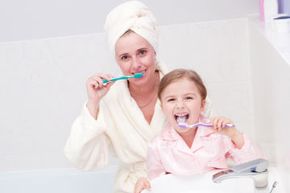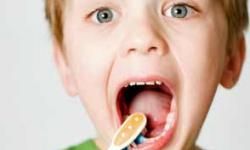More than 40 percent of kids have cavities by the time they enter kindergarten [source: CAC-IOHS]. That's a high percentage. Tooth decay is the No. 1 disease affecting young children today. It's five times more common in early childhood than asthma, and seven times more common than hay fever [source: American Academy of Pediatrics].
We can do better for our kids, and one step toward fighting cavities is practicing -- and teaching -- good teeth-brushing habits.
Advertisement
As children, we have 20 primary teeth, or baby teeth. It takes about three years for the complete set to come in, and by the time we turn 12 or 13 they're all gone, replaced by our adult permanent teeth. So, if baby teeth aren't meant to last more than a decade, why is it important to keep them healthy?
Our baby teeth act as guides for our permanent adult teeth. If they're lost prematurely due to decay, our adult teeth may not have enough room to properly come in. Poorly-cared-for baby teeth may also cause infection, pain and discomfort, and problems eating and speaking, as well as issues with low self-esteem.
Even before that first tooth appears, you can and should practice good oral hygiene habits at home. Before your infant has a toothy grin, it's important to keep those gums clean. Gently wipe them with a soft cloth or gauze and water, or with a moist infant-sized toothbrush after every feeding (remember: no teeth, no toothpaste). A secondary benefit of wiping those gums? Your baby may find the light pressure of rubbing offers a bit of relief from teething pain.
The appearance of your baby's first tooth may happen as early as 6 to 7 months old. The American Academy of Pediatric Dentistry recommends that parents schedule their child's first dental visit by her first birthday, or earlier if their child's first tooth begins to erupt before age 1. As soon as the first tooth appears, it's time to begin an at-home routine of brushing twice a day, preferably after breakfast and before bed. Use a soft, small-headed toothbrush and water to remove food, bacteria and other debris, as well as sticky plaque. Until your child is old enough to rinse and spit, don't use toothpaste.
When your child is about 2 or 3 years old, it's time to start teaching her to brush and care for her own teeth. Although teaching basic oral hygiene techniques and habits begins in toddlerhood, this is a process that spans the childhood years -- preschoolers, give or take a few years, don't have the fine motor skills to be experts at toothbrushing, so it's important to continue to teach and supervise your child's brushing habits until she's about 6 to 8 years old. Now that you know the plan of attack, let's talk tips.
Advertisement


